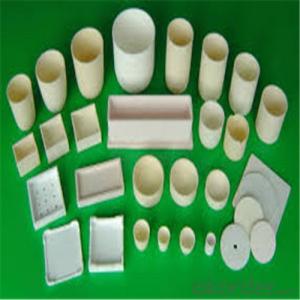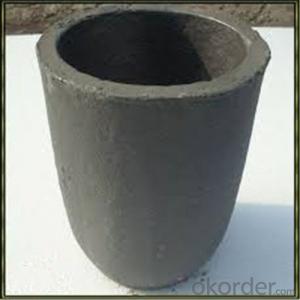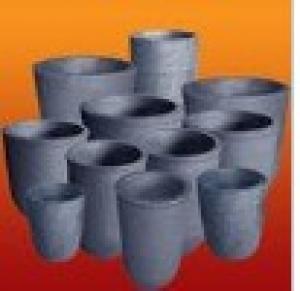SIC Graphite Crucible
- Loading Port:
- Shanghai
- Payment Terms:
- TT OR LC
- Min Order Qty:
- 1 pc
- Supply Capability:
- 1000 pc/month
OKorder Service Pledge
OKorder Financial Service
You Might Also Like
Quick Details
| Application: | melting metals | Height: | depends on your requirement | Top Diameter: | 10-1200mm |
| Bottom Diameter: | 10-1200mm | Place of Origin: | China (Mainland) | Brand Name: | |
| product name: | SiC graphite crucible china graphite crucible | top diameter: | 10-1200mm | bottom diameter: | 10-1200mm |
| height: | depends on your requirement | application: | melting gold,silver and other metals | Specific resistance: | ≤14μΩ.m |
| Bending strength: | ≥25MPa | Compressive strength: | ≥50MPa | Bulk densit: | ≥1.68g/cm3 |
| Ash content: | ≤0.15% |
Packaging & Delivery
| Packaging Details: | woden case for SiC graphite crucible china graphite crucible |
| Delivery Detail: | within 20 days |
Introduction
1. Graphite crucible can be used for non-ferrous metal smelting and casting, dissolving gold
or silver ornaments, analysis of special type steel, sintering hard metal.
2. graphite crucible for smelting gold is specialized in melting gold in headgear and jewelryindustry. That requests graphite material has high density and purity, ablation-resistance, and it can be used many times. We can machine various crucibles accordingto customer's requirement.
3. Machined from high pure graphite and widely used in the gold,silver,platinum and other noble metal's melting.If it's used in oxygen atmosphere,it wil start to be oxygenized when the temperature is higher than 700-800°c. If it's used in the protective atmosphere, it can stand more than 2000°c.
4. widely used in such fields as industrial furnaces, mono-crystalline silicon machinery, mono-crystalline silicon machinery, electron, semi-conductor, metallurgy, oil, chemistry, textile, electrical machinery, electrical equipment, electrical furnace, traffic, communication industry, medicine, etc.
Advantages
1.good thermal conductivity
2.High-temperature resistance
3. Small thermal expansion coefficient.
4.Strong corrosion resistance to acid and alkali liquid
5.Good chemical stability
Technology parameter
Item | Unit | High pure graphite | ||
baked twice | baked three time | baked four times | ||
impregnated once | impregnated twice | impregnated three times | ||
Grain size | mm | ≤325mesh | ≤325mesh | ≤325mesh |
Bulk density | g/cm3 | ≥1.68 | ≥1.78 | ≥1.85 |
Specific resistance | μΩ.m | ≤14 | ≤14 | ≤13 |
Bending strength | MPa | ≥25 | ≥40 | ≥45 |
Compressive strength | MPa | ≥50 | ≥60 | ≥65 |
Ash content | % | ≤0.15 | ≤0.1 | ≤0.05 |
We accept small orders,please inquiry us freely. | ||||
Item | Unit | Fine-grain Specialty Graphite model 1 | Fine-grain Specialty Graphite model model2 | ||
Guarantee value | Typical value | Guarantee value | Typical value | ||
Max grain size | mm | 0.8 | 0.8 | 0.8 | 0.8 |
Bulk density | g/cm3 | ≥1.70 | 1.73 | ≥1.73 | 1.76 |
Specific resistance | μΩ.m | ≤8.5 | 7.5 | ≤8.0 | 7 |
Bending strength | MPa | ≥10.0 | 11 | ≥12.0 | 12.5 |
Compressive strength | MPa | ≥24.0 | 27 | ≥31.0 | 34 |
Thermal Condcutivity | W/(m.k) | ≥120 | 150 | ≥130 | 160 |
C.T.E.(100-600) °C | 10-6/°C | ≤2.5 | 2.2 | ≤2.5 | 2.1 |
Ash content | % | ≤0.3 | 0.09 | ≤0.3 | 0.09 |
We are always avliable to service you! | |||||
Parts sizes of graphite crucible table
Product name | Dimensions(mm) | Weight(g) | |||
Φ1 | Φ2 | Φ3 | H | ||
1 kg graphite crucible | 58 | 47 | 35 | 88 | 160 |
2kg graphite crucible
| 65 | 58 | 44 | 110 | 240 |
2.5kg graphite crucible
| 65 | 58 | 44 | 126 | 300 |
3kg graphite crucible
| 85 | 75 | 60 | 105 | 390 |
4kg graphite crucible
| 85 | 75 | 60 | 130 | 500 |
4kg graphite crucible
| 85 | 75 | 60 | 136 | 500 |
5kg graphite crucible
| 100 | 89 | 69 | 130 | 700 |
5.5kg graphite crucible
| 105 | 90 | 70 | 156 | 800 |
6kg graphite crucible
| 110 | 97 | 79 | 174 | 970 |
We have all kinds of sizes graphite crucibles in stock,please feel free to contact us. | |||||
packaging & shipping
Packaging
1. For each type, we can send you the detailed high-resolution pictures since we have the sample in our hand.
2. For packaging, we have the professional packaging starff, pls. don't worry about the shipping.
Our service
1.Delivery time is 5~7 days for sample and 15 working days for bulk order;
2. Strong production capacity and strict quality control system;
3. Your inquiry and problems related to our products or prices will be replied in 24 hours;
4. Well-trained and experienced staffs to answer all your inquires;
5. After-sale tracking service for all of our clients;
6. OEM is available; small quantities, mixed bulk orders are also welcome;
7. Payment: L/C, D/A, D/P, T/T, Paypal , Western Union, MoneyGram;
8. Delivery way: UPS, DHL, TNT, FEDEX, EMS, CHINA POST.
After-Sales Service
1.1year warranty for most of our products;
2.We will arrange delivery of the goods on time:
3.Within the warranty period, we will bear all the qulity problem of our produts;
4.Beyond the warranty period, we will despatch the replacement parts to help fix the products;
5.Without any problem, we will gain the feedbacks of our products to help improve better products.
FAQ
Q:How to get in touch with us?
A:You can clik "Contact Supplier" above, or click "Chat Now!". We provide 24-hour service!
Q: How can I get free samples?
A: Only carbon brush for power tools/automobiles/motorcycle----no more than 4 sets for each model is free of charge.
Q:How to order?
A:Quotation→Price comfirming→Sign a contract→Mass production→Delivery
Q:How to pay?
A:30% T/T deposit.→70% balance by T/T against B/L copy.
Q:How to get after-sales service?
A:You can contact with your appointed sales.
You can also get in touch with our Quality Assurance Department: zdatzddt.com
Company Information


- Q: Can graphite crucibles be used for melting radioactive materials?
- Graphite crucibles can indeed be used for melting radioactive materials. Graphite is known for its high melting point, excellent thermal conductivity, and chemical inertness, making it a suitable material for containing and melting various substances, including radioactive materials. Additionally, graphite has low neutron absorption properties, which is crucial when dealing with radioactive materials as it minimizes the risk of neutron-induced reactions. However, it is important to note that special precautions and safety measures should be taken when handling and melting radioactive materials to ensure the safety of personnel and prevent any potential contamination or release of harmful radiation.
- Q: What are the different methods of preventing graphite crucible deformation?
- There are several methods to prevent graphite crucible deformation. One approach is to carefully control the heating and cooling rates to avoid sudden temperature changes, which can cause thermal stress and lead to deformation. Another method is to use proper handling techniques, ensuring that the crucible is not dropped or subjected to excessive mechanical stress. Additionally, applying a protective coating or using a high-quality crucible material can also help prevent deformation. Regular maintenance and inspection of the crucible can also identify any signs of deformation early on, allowing for timely replacement if necessary.
- Q: Graphite is widely used in industry and in daily life. It can not be used in industry
- General graphite in industry and daily life has been used in various fields, but the graphite can not be used by those who industry is a matter to be determined, so we can only go to research specific, what is the specific application of graphite materials, if you don't want to in the industry application of graphite material
- Q: What are the two methods of atomization? What orders of magnitude can be measured?
- Arsenic, quartz furnace atomizer (quartz furnace atomizer). The cathode sputtering atomizer burner is composed of three parts, the cathode surface characteristics, lead antimony, atomic absorption spectroscopy determination of a variety of elements, the pre mixing chamber is produced by glow discharge ion bombardment: Determination of C for refractory elements.
- Q: How do you use crucibles to process copper?
- The medium frequency furnace crucible is made of quartz sand lining material, and the crucible has a long service life, usually in three months. The power frequency furnace is also sintered with quartz sand.
- Q: Can graphite crucibles be used for melting composite materials?
- Indeed, composite materials can be melted using graphite crucibles. Renowned for their elevated melting point and excellent thermal conductivity, graphite crucibles are well-suited for the fusion of various materials, including composite ones. Moreover, their resistance to chemical reactions renders them optimal for managing and confining composite materials while undergoing the melting procedure. Nevertheless, it is crucial to thoroughly assess the composite material's specific composition and melting point to guarantee its compatibility with the graphite crucible.
- Q: What is the main function of graphite?
- For casting, casting, molding and high-temperature metallurgical material: Graphite due to thermal expansion coefficient is small, and the capability of cold and hot change, can be used as a mold of the glass, the use of graphite after black metal castings get precise size, smooth surface, high rate of finished products, can be used without processing or minor processing, thus saving a lot of metal. A powder metallurgy process, such as hard alloy, usually made of graphite material and used as a porcelain boat for press and sintering. The crystal growth of monocrystalline silicon, crucible, zone refining vessel, bracket, jig and induction heater are all made of high purity graphite. In addition, graphite can be used as vacuum heating graphite insulation plate and base, high temperature resistance furnace tube, rod, plate, lattice and other components.
- Q: Why can't a f containing compound be used in a porcelain crucible, a Lilac Garden?
- The F containing compound can not be used in the ceramic crucible for combustion and drying. The main reason is that the corrosion of fluorine on porcelain at high temperature.
- Q: You solved it. What happens if a quartz crucible is coated with a graphite crucible?
- The graphite crucible will burn on an alcohol burner, and the quartz crucible may cause cracks due to uneven heat.
- Q: Can graphite crucibles be used for melting nickel?
- Yes, graphite crucibles can be used for melting nickel. Graphite crucibles are commonly used in high-temperature applications, including the melting of various metals and alloys. Graphite has excellent thermal conductivity and can withstand high temperatures, making it suitable for melting nickel, which has a melting point of around 1,455 degrees Celsius (2,651 degrees Fahrenheit). Additionally, graphite crucibles have good chemical resistance and do not react with nickel, allowing for a clean and efficient melting process.
Send your message to us
SIC Graphite Crucible
- Loading Port:
- Shanghai
- Payment Terms:
- TT OR LC
- Min Order Qty:
- 1 pc
- Supply Capability:
- 1000 pc/month
OKorder Service Pledge
OKorder Financial Service
Similar products
Hot products
Hot Searches
Related keywords





























